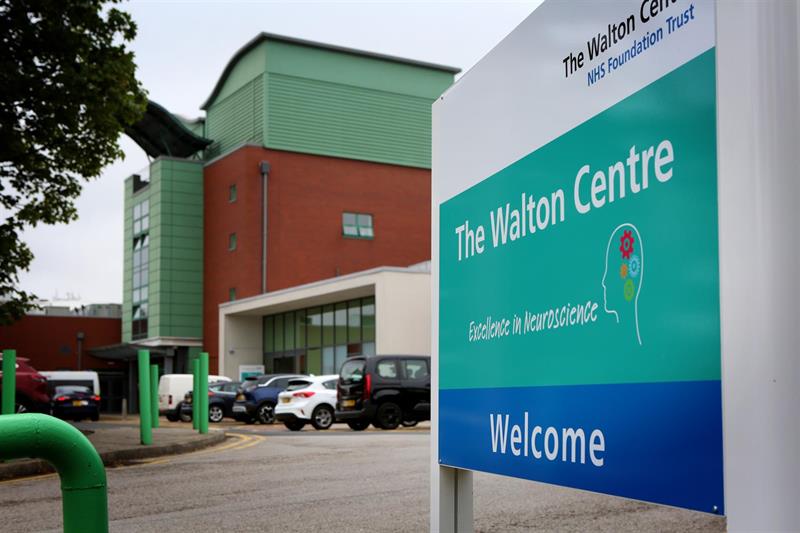Neurovascular surgery and intervention
Service contact information
- Neurovascular Nurse Specialist telephone (answer phone) offers a daily non-urgent call back service and can be contacted on 0151 556 3325. (Calls are not always answered the same day)
- Neurovascular secretary to consultants 0151 556 3352
Service detail
The neurovascular surgery and intervention service treats intracranial conditions involving diseases of cerebral blood vessels. The team predominantly treats acute patients, but also treats elective patients. The greatest proportion of the service is treating patients with acute sub-arachnoid haemorrhages from ruptured aneurysms.
Other conditions treated include arteriovenous malformations, dural arteriovenous fistulas, incidental and symptomatic aneurysms, intracerebral haemorrhage, subarachnoid haemorrhage without a cause being found and cavernoma.
Support is also provided to Alder Hey (such conditions are very rare in children).
The service consists of neurosurgeons, neuro-interventional neuroradiology consultants, neurovascular secretary, specialist radiographers, Theatres Department, an advanced nurse practitioner and nurse specialists.
Patient management and care is a multidisciplinary approach with a weekly multidisciplinary team (MDT) meeting, which can be requested/accessed by discussing with the medical team.
The neurovascular neurology service can also be closely involved in cases where surgery isn’t required.
Inpatient and ongoing care is supported by a multidisciplinary team of therapists and the Cheshire and Merseyside Rehabilitation Network.
A ‘Road to Recovery Programme’, with input from the medical, nursing and therapy team and support from the Brain Haemorrhage Support Group, aims to support patients following aneurysmal subarachnoid haemorrhage.
Research
The service participates in a variety of national trials, including ARUBA, STASH, HELPS, TEAM, carotid artery stenting vs endarterectomy and CARE studies in hyponatraemia in sub-arachnoid haemorrhage.
Getting here
The Neurovascular Team are located in the main building at The Walton Centre although they also offer a support service to Alder Hey Children’s Hospital
The Walton Centre - Main Hospital Building

This building hosts many of our in-patient services, including wards and theatres, and some outpatients services.
Address
Lower Lane, Liverpool, L9 7LJ
Directions and map
- View The Walton Centre - Main Hospital Building on a map
- Get directions to The Walton Centre - Main Hospital Building
The Walton Centre NHS Foundation Trust is not responsible for third-party sites or content.
Referral information
Emergency inter-hospital referrals can be made via the neurosurgical registrar via The Walton Centre switchboard or via https://www.orion.net/
Routine and urgent referrals can be made via GP surgeries.
Patient leaflets

Brain Aneurysms and Screening
An aneurysm is formed when there is a weakness in the blood vessel (artery) causing a ballooning or ‘out-pouching’ that fills with blood.

Carotid and Vertebral Artery Stenting
Carotid or vertebral artery stenting is an endovascular treatment which means it is performed through a blood vessel by a consultant interventional neuro-radiologist. The procedure is usually carried out under local anaesthetic.

Cerebral Cavernomas
Cavernoma are abnormal clusters of vessels with small bubbles (sometimes known as caverns) filled with blood that make them look like a raspberry or blackberry. Cavernomas are also known as cavernous angioma, cavernous haemangioma or cerebral cavernous malformation (CCM).

Cranioplasty
Cranioplasty is the surgical repair of a bone defect in the skull resulting from a previous operation or injury.

Dural Arteriovenous Fistula Of The Brain (DAVF)
WHAT IS A DURAL ARTERIOVENOUS FISTULA?
- It is one or more abnormal connections from an artery supplying the dura of the brain to a vein or venous sinus draining it. The abnormal connection (s) is/are called fistula.

Elective Endovascular Occlusion of Brain Aneurysm
A brain aneurysm is a fault or weakness in the wall of one of the blood vessels supplying blood to the brain.

Intraventricular Haemorrhage
What is an intraventricular haemorrhage (IVH)? This is bleeding inside or around the ventricles which are the fluid compartments of the brain

Reversible cerebral vasoconstriction syndrome (RCVS)
Reversible cerebral vasoconstriction syndrome (RCVS) is a neurological disorder characterised by a sudden onset of severe headache associated with narrowing of blood pipes (intracranial vessels) that supply blood to the brain.
Page last updated: 23 June 2021
64